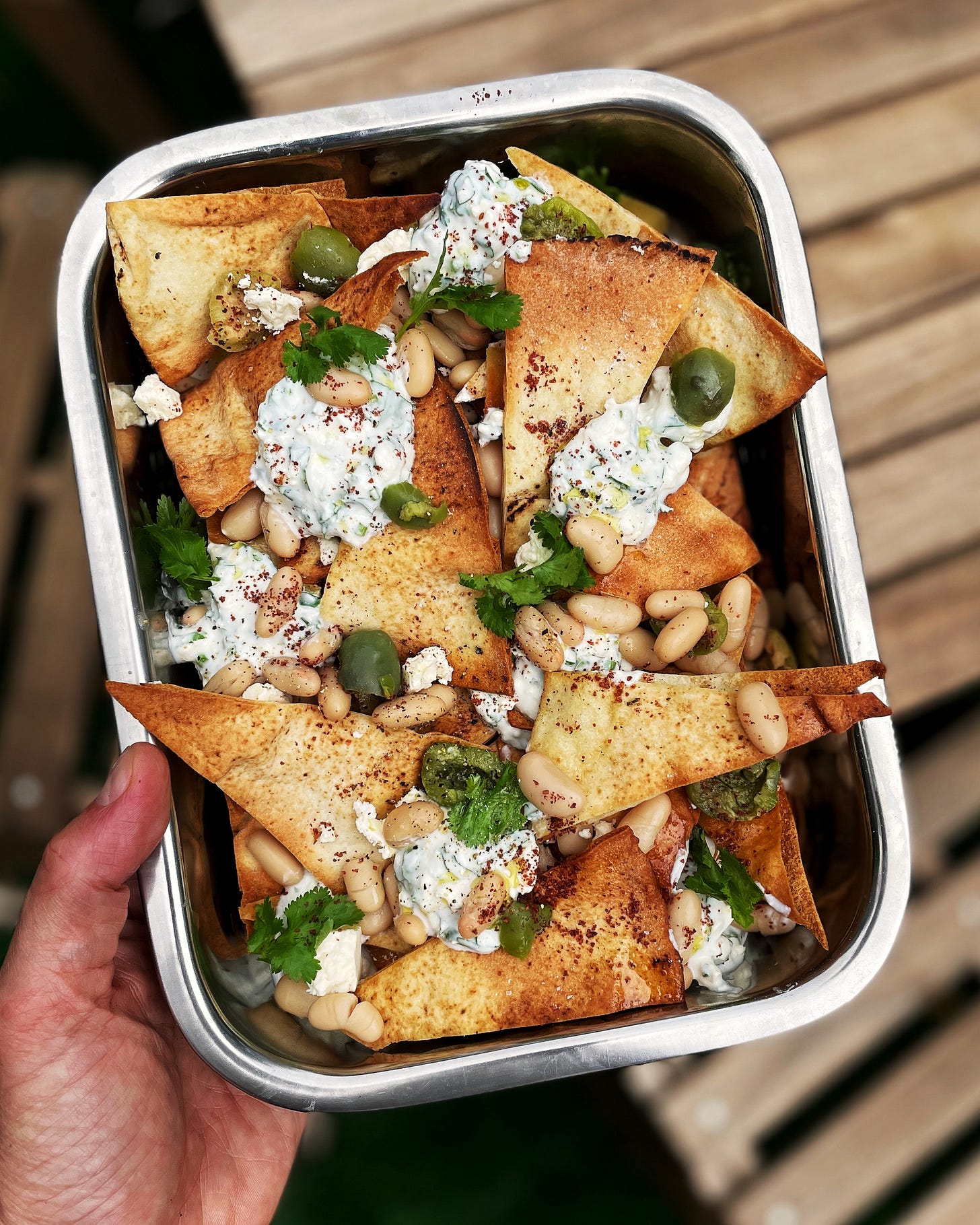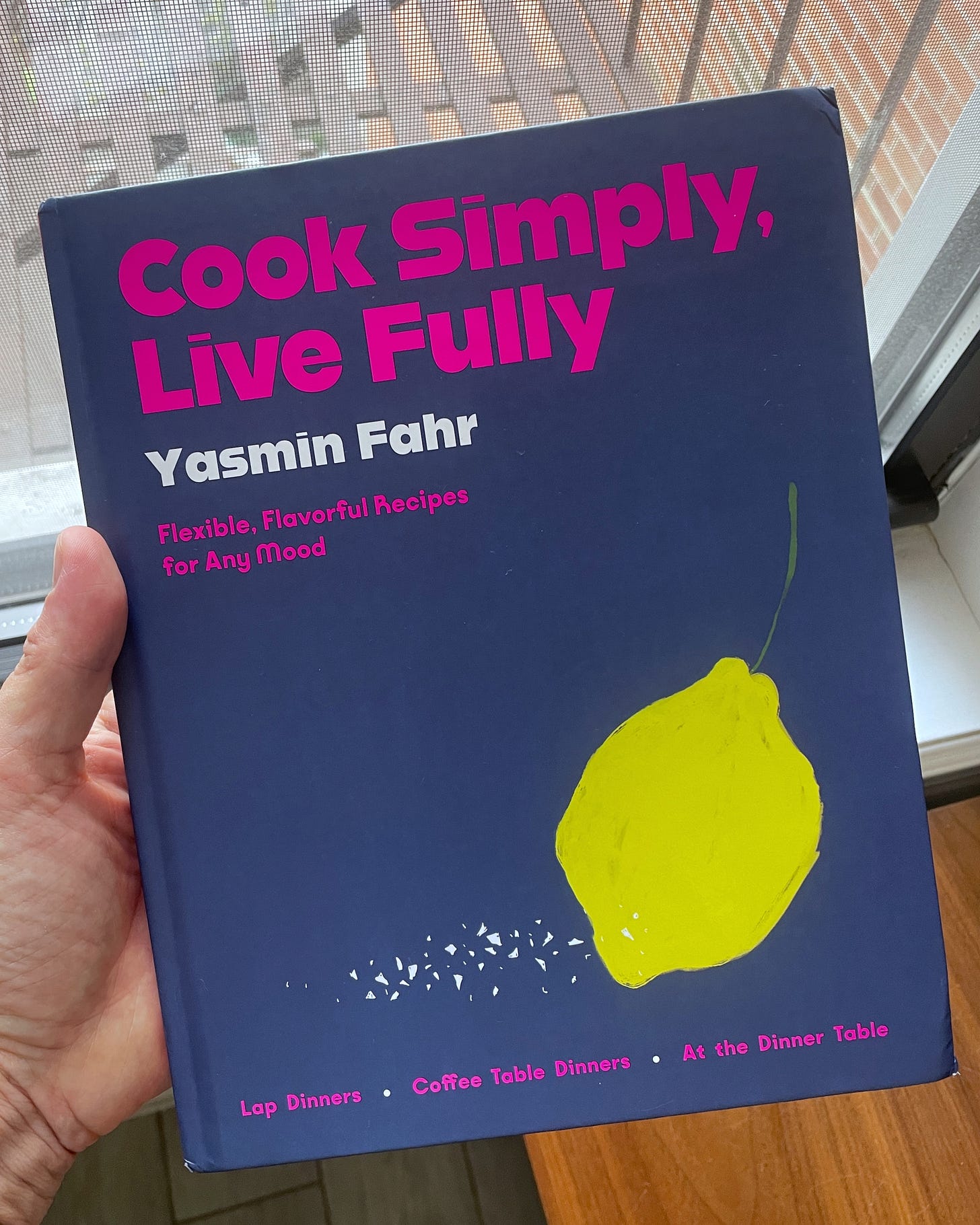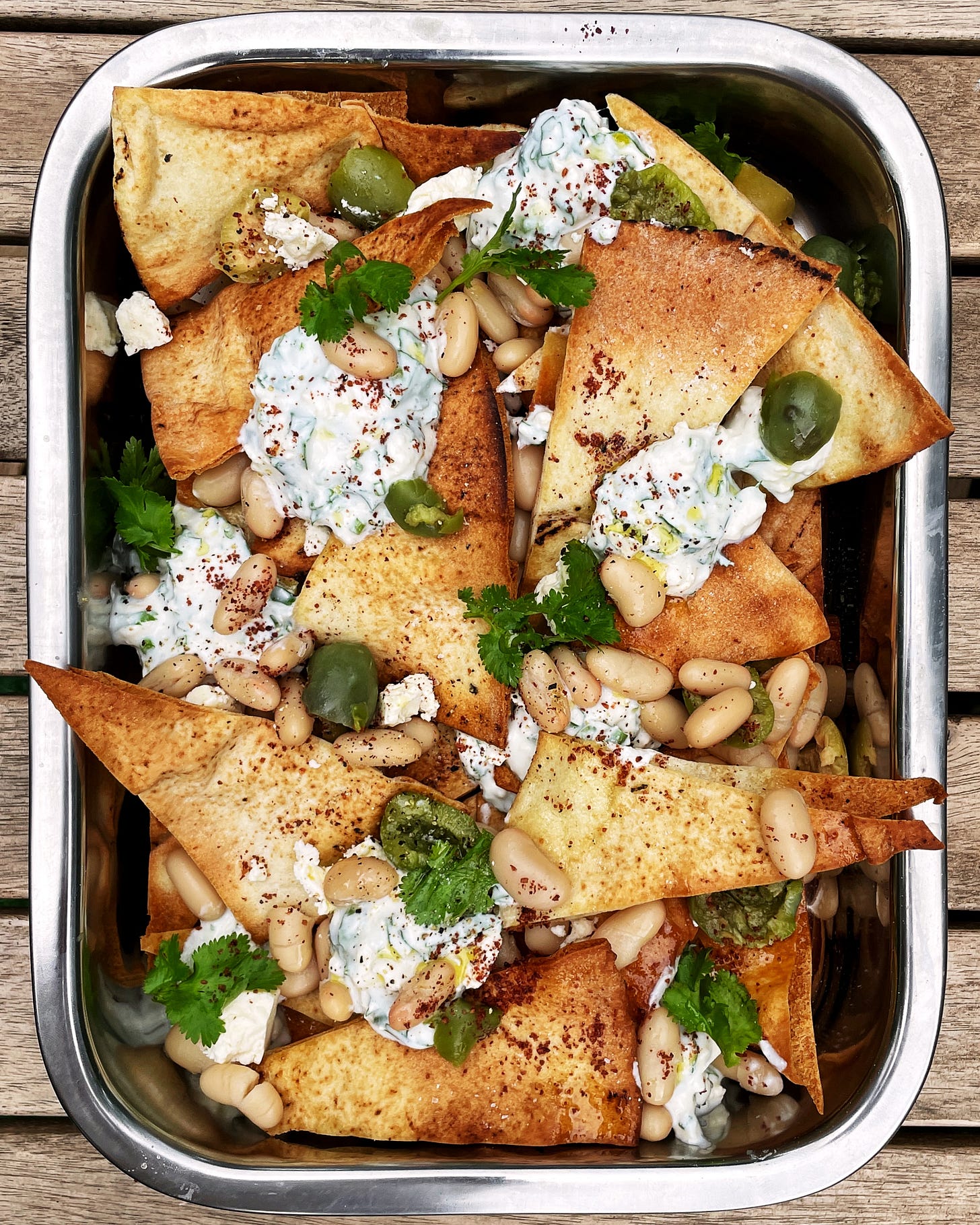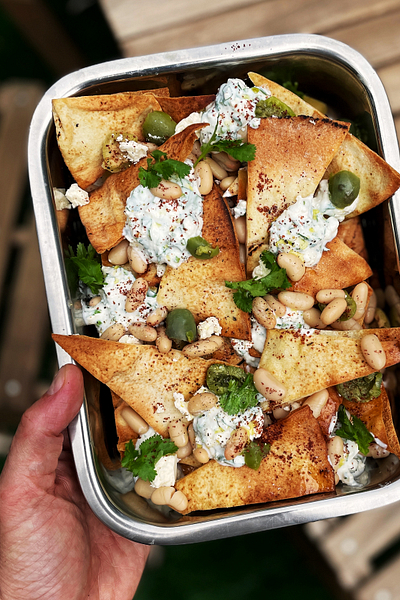Yasmin Fahr's Mediterranean Nachos
Endlessly riffable — plus a Q&A about her terrific new book Cook Simply, Live Fully
From the moment I heard the title and saw the bold, purple cover and hot-pink type, I was drawn to
’s new cookbook Cook Simply, Live Fully. It’s cleverly organized around energy level, with recipes that require as little or as much effort as you’ve got any given night, ranging from “lap dinners” (most minimal) to “coffee table dinners” (some required, but not a lot) to “at the dinner table,” for when there’s time to spare or you might be entertaining.This could lead you to believe that the recipes are full of hacks or shortcuts in the form of store-bought premade things, but that’s not the case. Instead, flavor from whole-food ingredients are coaxed in new, simple ways, and the sometimes rigid, prescriptive nature of a traditional recipe is cleverly loosened up, to make cooking easier, less stressful, and hopefully more enjoyable.
If you’re not familiar with Yasmin, she’s written two other cookbooks and contributes regularly to the New York Times, among other publications. I feel like I can always spot one of her recipes from a distance, because the flavors leap off the page (or the screen).
I was so happy Yasmin agreed to answer a few questions about Cook Simply, Live Fully and go into some detail about what makes it such a special book. And I love how it documents a transitional point in her life (spoiler alert: she’s currently living in Menorca, Spain!).
She also graciously allowed me to share her recipe for Sheet-Pan Mediterranean Nachos (scroll all the way to the bottom), which I’ve been making on repeat. I hope you give it a try, and check out Yasmin’s book!
Q&A with Yasmin Fahr
Where are you now, and what's the most recent thing you cooked?
I'm currently in Menorca! I moved into a lovely little house in Ciutadella in early March. It’s been great, not without its adjustments, of course, but I’m happy with the choice to move here. I actually cook most of my meals here, and rarely eat out. But I’m currently developing a bunch of recipes, so when I’m not making those I’ve had a boring-sounding but delicious diet of bread and cheese. There is this bread here made with xeixa, which is an ancient grain grown on the island that I love. And a friend here makes the most unbelievable goat cheese—he has one that’s “fresh” and it’s delicate yet richly flavorful with a silky texture almost like silken tofu or good flan, so I’ve been eating that on bread, drizzled with olive oil from a regenerative farm here and a tiny bit of salt. So good!! Simple goodness. Though the last thing I made for fun was a hodgepodge vegetable dish. I cooked down about a pound of leeks, then topped it with about a pound of chopped rainbow chard and stems, poured in a mixture of olive oil, lemon and mustard, then topped that with croutons that I made in the pan earlier and then covered it all with grated Mahon cheese (that’s from here!). I covered the pot and let it cook for about 20 minutes on low. It was a lovely mixture of textures with some of the croutons staying crunchy, some soaked with juices, plus the wilted greens and melty cheese and a little bit of soupiness at the bottom. We had a couple weeks of chilly weather so it was perfect for a Sunday night.
Can you tell us about the book's title? Was your approach to it different from your previous books?
The story of the title still surprises me as I can't quite believe how it all worked out. So I came up with it about four years ago, during the start of the pandemic, and I didn't really know where or how I wanted to use it, but I really liked the obvious concept of it and what it stood for. It was one of those things that I kept tucked away in the back of my mind. And, when I found myself in Menorca about two years ago, writing this book, it felt like the perfect title for the introduction. The introduction goes into this unexpected life journey I've been on the past few years, when I fell in love with this island in September of 2021 and had one of those moments of clarity where I knew I needed to change my life and move here, I just had absolutely no idea how I was going to make any of that happen. I had a lease, work in NYC, and I also didn't know a single person on the island or speak the language. Long story short, I did move out, ended up being a “traveling cook” in Menorca for about seven weeks when I couldn't find an apartment to land in Miami (still not entirely sure why I thought it was a good idea to move there), working on the book.
I've realized over these past couple of years that I want a “full” life, but one that's full of things that I want it to be full of, rather than just a crazy hectic day where I have no idea what happened and feel depleted and drained at the end and just want to hide under the covers in the dark.
During this solo period, I spent a lot of time with myself, which was great, and I realized that I decide what to cook based on the energy I have and my mood (and the weather!). And that's why the book is organized by the energy you have to make dinner. I felt so often that I would force and push myself to do things because I thought it was “the right thing to do” or “what I was supposed to do” and, at the end of the day, it was really me making up these arbitrary rules for myself and stressing myself out for no reason. Part of me making this life change is trying to simplify my life and start enjoying it rather than always feeling so stressed out about work and anxious and “busy.” And I think I've realized over these past couple of years that I want a “full” life, but one that's full of things that I want it to be full of, rather than just a crazy hectic day where I have no idea what happened and feel depleted and drained at the end and just want to hide under the covers in the dark. I still work really hard and feel tired at the end of the day, but I also feel really satisfied. So it’s really this idea of doing the things that make me happy but in the most simple of ways—and applying that to cooking every day. (I’m still a work in progress, as I don't want to sound like someone who made a life move and is like, My life is perfect and so am I! Definitely not the case.)
Anyway, the book was originally called What's for Dinner, but then we learned a book came out in the UK in Feb of last year with the same title, so we decided to move the title from the introduction, and I'm really happy about it because it really captures the intention of the book. And, I find it a bit crazy that this title came to me so long before I went through this journey or had any of these experiences, which ended up influencing this book in so many ways.
In terms of my other books, I was given a lot of creative freedom with this one, and, while it is a dinner book at the end of the day, it's also a deeply personal one because it captures this huge life change that I've gone through, even though it wasn't intentional when I first pitched it. I remember writing to my agent and editor when all of this was going on, trying to reassure them that I hadn’t lost my mind, and I was still going to hit our target dates and so on. And they were super supportive about it, thankfully.
I struggle with how to convey the flexibility of cooking within the prescriptive nature of recipe writing. In your book, you’ve addressed it head-on in such a fun way. Could you share a bit about how you developed your approach?
Oh thank you!! I'm really excited about this part of the book, so I'm glad you touched on it. So, for the Lap Dinner chapter, traditional measuring spoons and cups aren’t used, and this came about in two ways. First, I was visiting my cousin in the UK, and, to simplify it, they don’t use measuring cups—they weigh things instead. So when she told me how she just used a teacup when recipes called for a cup, I thought, well, that would be a lot easier, wouldn't it? Which was one seed planted. And, the second was because I had forgotten my measuring spoons during this seven-week writing retreat and no matter how many cooking stores I went to, showing them photos of what I was looking for, none had any and most of them didn't really know what I was talking about. I started using "a small spoon" so not your big soup spoon but not your demitasse spoon either and felt it was a much easier way to cook, especially for a chapter when you're exhausted and don't feel like cooking—so isn't it much easier to spoon things out of jars and drizzle right from the bottle? And these are the measurements used in the Lap Dinners section (there's an illustration of the spoon size that’s true to size and other guidelines, too, so you're not left alone, I promise). I think with recipes, and maybe in all of life, we want to feel supported and guided but also have room to grow and expand, so my goal was to do just that. There are measurements in this “different” way, but they are still there and hopefully it's also showing cooks just how much room they have to play and also pushing them (gently!) to use their instincts and eyes/smell/taste versus just relying on the words on the page.
What I find hilarious is that I never thought about why I couldn't find measuring spoons until a couple weeks ago when it all came full circle. My Spanish teacher (who is so wonderful) brought me a cookbook from the early 2000s from a famous Basque chef, and I was supposed to go through it and translate. As I’m reading the ingredient list, it says “½ cucharada XYZ” and then “1 cucharadita XYZ” basically saying, ½ spoon of this, 1 little spoon of this, because they don’t use measuring spoons in Spain!! (That's why I couldn't find any!!) I, of course, jumped up and got so excited, grabbing my cookbook to show her, saying, look!! I did the same thing and rambled on excitedly. Of course, this was not exciting for her in any way because it was the way she cooked, and she gave me a polite blank stare as I chattered on. I also loved how the cookbook said to grab a water glass and fill it halfway with wine as it's such a relaxed approach to cooking that’s also realistic. I feel that sometimes we remove the inherent flexibility from cooking by being overly rigid with amounts and so on and making everyone worry so much about measuring perfectly (I know in baking it’s a different story). We all have different tastes and preferences, so, while someone on the whole might agree with my palate, they might like a little more salt or a little less cumin than I do, which also makes sense. I like to think of my recipes as a guideline—if you’re new and want to be told what to do, then follow everything to the letter, and you’ll be good. But, if you want to play with the recipe, making it your own, then that would make me even happier. I want them to be used and enjoyed, however is best for you.
What are the cooking essentials that you always pack with you when you travel?
I've whittled my knife kit down to the basics: a chef's knife, a santoku knife, a paring knife and bread knife. I also have my magenta ruler (the same one that is on the spine of the book!), two sets of measuring spoons, 1 liquid cup and 1 set of dry measuring tools—these are because I'm still recipe developing—a pair of tongs, a fish spat, a wooden spoon, rubber spatula and Microplane. Basically, the tools I recommend in my cookbook as I really don't need much else and like to keep things simple in general. I found when going to different AirBnBs, they are all stocked so differently, and it’s hard to tell from the description or photos of what they have. I've been lucky in a couple where the owner clearly loves to cook so the kitchen has everything you could want, but I’ve also been in some where it’s clearly just a rental property, and it has “the basics” but they are just so poor quality and not really meant for cooking, so these are also the things I’ve found that I need. Embarrassingly enough, I brought a half sheet pan all the way from LA to Menorca and, big surprise, it didn't fit in my oven! I don't know why I didn't think about that, but I did not.
For more information, be sure to check out Yasmin’s Substack newsletter:
Yasmin Fahr’s Sheet-Pan Mediterranean Nachos
From Yasmin: “I think there’s something so enjoyable about eating this way, whether for dinner, snacking, or sharing plates. While I love more traditional nachos, I tend to lean more to this flavor profile, which means it’s
essentially all my favorite snacking foods on one giant plate. It looks like a lot of ingredients, but please forge ahead as you’re mostly piling a ton of delicious ingredients on top of each other. Pita chips can be made one of two ways: Either peel apart the two layers of the pita for thinner chips, or keep them as is for thicker ones. Here we’re going for thicker chips that can hold up to the
toppings.”
This is such a lovely, bright, fresh flavor profile — the olives, herbs, feta, and little hits of heat from the harissa. I can imagine taking it in a breakfast direction, serving the assembled “nachos” in shallow bowls and topping each one with a poached or fried egg.
Yield 4 servings | Prep time About 20 minutes | Source Cook Simply, Live Fully
5 large pitas (6-inch), cut into 8 wedges each
3 tablespoons olive oil, plus more for garnish
Salt
15-ounce can white beans, drained and rinsed
1 cup full-fat yogurt
Juice of 1 lemon
¼ cup packed parsley or cilantro, roughly chopped, plus more for garnish
½ teaspoon ground cumin
¾ cup crumbled feta
2 cups castelvetrano olives, pitted and halved or torn
2 to 4 tablespoons harissa
1 teaspoon sumac or za’atar
Flaky sea salt
2 tablespoon fresh dill
1. Heat the oven to 400°F. Spread the pitas out on a sheet pan and toss with 2 tablespoons olive oil, adding more as needed so that they all have a light coating, then season lightly with salt. Put the beans on another sheet pan, drizzle with the remaining 1 tablespoon olive oil, and season lightly with salt, then toss to combine. Bake until the beans are warmed, 4 to 6 minutes, and the pita wedges are crispy and browned, 10 to 12 minutes. (If you have the energy, flip the pita wedges halfway through, but I’m always too lazy to do this, and it’s fine; note that they will continue to brown out of the oven.) Let cool slightly along with the beans.
2. Meanwhile, in a small bowl, mix the yogurt, lemon juice, chopped parsley, and cumin until the juice is incorporated. Stir in ½ cup of the feta.
3. On a large serving platter or two large plates, create a layer of pita chips. Top with half the remaining feta, half the beans, and half the olives, and use a spoon to create small piles of yogurt around the chips. Repeat with another layer of chips, then add the remaining toppings. Dollop some harissa here and there, depending on your heat preference. Sprinkle everything with the sumac, some flaky salt, the dill, and the parsley sprigs, and serve warm.









This sounds totally like something I would make--but different. (Teehee, you know me--recipes are all inspiration.) I would use my own Sourdough "chips", add GARLIC to the beans, serve the harissa separately since Donn doesn't do "heat" (he loves his butt and "hot stuff" hurts on the way out --insert face palm here), and mix the no-fat Greek yoghurt in my fridge with some homemade kefir. The rest I would leave the same. I don't think I've ever had castelvetrano olives -- so this will be my "new" veggie for the week. Thanks for the awesome interview and recipe. It's kind of like a "snack for dinner" ;)
So delicious! I love Yasmin's book, and these look so satisfying.